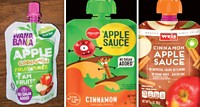Advertisement
Grab your lab coat. Let's get started
Welcome!
Welcome!
Create an account below to get 6 C&EN articles per month, receive newsletters and more - all free.
It seems this is your first time logging in online. Please enter the following information to continue.
As an ACS member you automatically get access to this site. All we need is few more details to create your reading experience.
Not you? Sign in with a different account.
Not you? Sign in with a different account.
ERROR 1
ERROR 1
ERROR 2
ERROR 2
ERROR 2
ERROR 2
ERROR 2
Password and Confirm password must match.
If you have an ACS member number, please enter it here so we can link this account to your membership. (optional)
ERROR 2
ACS values your privacy. By submitting your information, you are gaining access to C&EN and subscribing to our weekly newsletter. We use the information you provide to make your reading experience better, and we will never sell your data to third party members.
Environment
Food Dye Debate Resurfaces
FDA considers evidence to support link between behavior and artificial colors
by Britt E. Erickson
April 18, 2011
| A version of this story appeared in
Volume 89, Issue 16

Artificial colors have been making processed foods look more appealing for decades. But renewed fears about a link between the consumption of chemically synthesized dyes and behavioral problems in children have prompted regulators to take a closer look at the safety of color additives in food.
An expert panel, convened by the Food & Drug Administration, grappled with dozens of studies on the behavioral effects of food dyes at a two-day meeting late last month in Silver Spring, Md. Despite compelling anecdotal evidence from people who claimed that their behavior or their children’s behavior has been adversely affected by particular food dyes, the committee concluded that the scientific evidence is inadequate to support a link between synthetic food dyes and behavioral problems, such as hyperactivity.
By a vote of 8-6, the committee recommended that FDA not require warning labels on food products containing artificial dyes. Currently, such dyes must be listed by name on food ingredient lists.
The committee identified several key gaps in the existing studies, including poor exposure and usage estimates for food dyes, the absence of behavioral effects data on individual dyes, and the lack of dose-response relationships and chemical mechanisms for the behavioral effects of food dyes.
Although the panel recommended further studies to address these and other gaps, it is unclear who would support such work. The National Institutes of Health is funding little research in this area, and FDA has yet to require industry to conduct such research.
The lack of ongoing research was brought up as a concern at the meeting by committee member F. Xavier Castellanos, an expert in child psychiatry at New York University Langone Medical Center. “The stance in the field that I work in is that this is a dead issue and there is no reason to devote resources to it,” he said.
Castellanos and others on the committee worry that their conclusions will be interpreted as saying artificial food colors don’t cause behavioral problems in kids. There is inadequate evidence to suggest that food dyes cause such effects, but there is also inadequate evidence to suggest that they don’t. “We are left with science that can’t support a causal claim, but it also doesn’t support the absence of causal claims,” Castellanos emphasized. “Absence of evidence is not evidence of absence. We don’t have the data to support the assertion that there is no relationship.”
The claim that food dyes have the potential to cause behavioral effects in children has been controversial since the 1970s. The bulk of the research was conducted more than 30 years ago, but a study published in 2007 by researchers at the University of Southampton, in England, sparked renewed interest in the field (Lancet, DOI: 10.1016/S0140-6736(07)61306-3).
The Southampton study led to mandatory warning labels on food in the European Union about a potential link between six artificial food dyes and hyperactivity in some children. Three of the six dyes—Yellow No. 5, Yellow No. 6, and Red No. 40—are allowed in food in the U.S. Three of them—Yellow No. 10, Carmoisine, and Ponceau 4R—are not allowed in U.S. food. All six compounds belong to the azo family of dyes, meaning they have a nitrogen-nitrogen double bond.
The study also led to a petition in the U.S. in 2008 by the Center for Science in the Public Interest (CSPI), a consumer advocacy group (C&EN, June 9, 2008, page 32). That petition urges FDA to ban eight artificial food dyes, including the three U.S.-approved azo dyes examined in the Southampton study, because of their association with hyperactivity and other behavioral problems in children. It also eventually prompted FDA to hold last month’s advisory committee meeting.
CSPI acknowledges that there are inconsistencies in the scientific data regarding the behavioral effects of food dyes, but the group claims that there are no benefits to putting artificial colors in food. “Synthetic food dyes have no nutritional value and no health benefits. They are not preservatives,” Michael Jacobson, executive director of CSPI, noted at the meeting. “They are used primarily to trick people into thinking that a food contains fruit or other valuable ingredients,” he said.
Color additives do have several legitimate uses, pointed out Mitchell Cheeseman, acting director of FDA’s Office of Food Additive Safety. For example, they offset color loss, correct natural color variations, enhance naturally occurring pigments, and provide a vibrant identity to otherwise colorless foods, he stated.
Artificial food coloring in the U.S. food supply has been steadily increasing over time, according to FDA and industry officials. “Because FDA must certify individually manufactured batches of some colors, FDA has annual information related to production of these additives,” Cheeseman noted. “In 2010, FDA certified batches with color additives amounting to over 15 million lb manufactured for all uses,” he said.
The amount of dye certified by FDA, however, is not the same as the amount of dye that ends up in the food supply, pointed out Sean Taylor, scientific director of the International Association of Color Manufacturers, an industry group. The exact amount of synthetic dyes used in food is unknown because those numbers are considered confidential business information, he said.
Regardless of this fact, FDA currently uses the total amount of certified color additives to estimate daily exposure levels from food, an approach criticized by several panel members. “The exposure assessment is an embarrassment to FDA,” said committee member George Gray, a toxicologist at George Washington University.
Committee member Carl K. Winter, a food toxicologist at the University of California, Davis, suggested FDA collaborate with the food dye industry to better predict the amounts of each dye in individual foods. A careful exposure assessment would allow FDA to “get a pretty good idea of which dyes are actually being consumed at what levels,” he said.
Those numbers could then be used along with food consumption data from the National Health & Nutrition Examination Survey or a similar program to better estimate exposure levels. NHANES is a program run by the Centers for Disease Control & Prevention to assess the health and nutrition status of Americans. Better exposure estimates would help researchers determine what dosages to use in future studies, Winter added.
Industry representative Taylor agreed that more work is needed to estimate exposure levels. “We would like to try to refine those exposure estimates with FDA,” he said, suggesting that surveying his organization’s members and the larger color industry might be a viable approach.
Several committee members pointed out that it is important to get a handle on exposure because the estimated daily intake levels are closely approaching currently acceptable levels for the three U.S.-certified azo food dyes.
Some members also questioned the accuracy of FDA’s acceptable daily intake values, which are calculated by taking the highest concentration that produced no observed effects in test animals divided by a safety factor of 100. That safety factor includes a factor of 10 for interspecies variability multiplied by a factor of 10 for extrapolating from animals to humans.
None of the studies used by FDA to calculate the acceptable daily intake levels for certified food dyes examined behavioral or developmental neurotoxicological effects. As a result, “there is a significant risk that the [acceptable daily intake levels] are set too high,” stressed Charles V. Vorhees, a pediatric neurologist at Cincinnati Children’s Hospital Medical Center and a member of the committee.
Vorhees also asked whether FDA’s safety factor of 100 is adequate to protect children and infants. The Environmental Protection Agency typically uses a factor of 1,000 when determining safety thresholds for chemicals, he noted. The additional factor of 10 is used by EPA to better protect children and infants.
Another challenge facing FDA is the lack of data on the behavioral effects of individual dyes. Dozens of studies, including the Southampton study, provide evidence that behavioral effects can occur in some children exposed to mixtures of dyes. The existing data do not, however, allow FDA officials to tease apart which dye is causing an effect.
Because of the lack of data on individual dyes, “I suspect that banning dyes would be a challenging and probably futile legal process,” CSPI’s Jacobson noted. But for now, FDA should require warning labels on food containing artificial colors, he said.
One artificial food dye in particular—Blue No. 1—grabbed the committee’s attention because of its ability to cross the blood-brain barrier. “We don’t see any significant amounts of colors in the brain in any of the animals, with the single exception of Blue 1,” industry’s Taylor told the committee. “Blue 1 seems to have different transport properties,” he said.
“Blue No. 1 should be put at the top of somebody’s list,” Castellanos remarked. Other research needs highlighted include establishing a dose-response relationship for each dye, revealing the underlying mechanism that leads to behavioral effects from dyes, and developing standards for measuring behavioral changes in children.
After more than 30 years of debating whether food dyes cause behavioral problems, “we don’t have the quality of data that we would like,” said Lisa Lefferts, an environmental health consultant and the consumer representative on the committee. “How many more years are going to pass until we have that kind of data?” she asked.







Join the conversation
Contact the reporter
Submit a Letter to the Editor for publication
Engage with us on Twitter